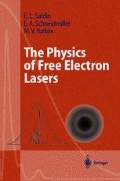Abstract
In the middle of the 1970s John Madey and colleagues constructed the first free electron laser operating in the infrared wavelength range. Since that time tremendous progress has been made in the FEL technique and free electron lasers now occupy an appropriate place among other sources of coherent radiation. When the first operating free electron laser was constructed, it seemed that FELs would form only a small supplement to a long list of available at that time quantum laser. Actually, the appearance of FELs led to a new direction for sources of coherent radiation: they embodied the type of coherent source to which all experimenters have aspired since the invention of the laser. It is relevant to note that despite the FEL being referred to as a laser, the principle of its operation is similar to that of conventional vacuum-tube devices: it is based on the interaction of electron beams with radiation in vacuum. From this point of view FELs form a separate class of vacuum-tube devices capable of generating powerful coherent radiation at any wavelength from the millimeter to the X-ray part of the spectrum similar to the vacuum-tube devices which generate coherent radiation at any wavelength, from the kilometer to the millimeter range. Also, free electron lasers possess all the attractive features of vacuum-tube devices. FEL radiation is always totally polarized and has ideal, i.e. diffraction, dispersion. FELs are capable of providing a high efficiency of transformation of the electron beam power into radiation power. Remembering that electron accelerators of driving beams for FELs can provide high average and peak power with an effective transformation of electric power into electron beam power, one can expect to reach a high level of total FEL efficiency and high peak and average output radiation power.
Access this chapter
Tax calculation will be finalised at checkout
Purchases are for personal use only
Preview
Unable to display preview. Download preview PDF.
References
L.R. Elias, Phys. Rev. Lett. 36 717 (1976)
D.A.G. Deacon, Phys. Rev. Lett. 38 892 (1977)
C.A. Brau, Free-Electron Lasers ( Academic Press, New York, 1990 )
C. Yamanaka, Nucl. Instrum. and Methods A 318 1 (1992)
G.R. Neil, Nucl. Instrum. and Methods A 358 159 (1995)
R. Brinkmann et al. (Eds), “Conceptual Design of 500 GeV e+e- Linear Collider with Integrated X-ray Facility”, DESY 1997–048, ECFA 1997–182, Hamburg, May 1987
A VUV Free Electron Laser at the TESLA Test Facility: Conceptual Design Report“, DESY Print TESLA-FEL 95–03, Hamburg, DESY, 1995
J. Rossbach, Nucl. Instrum. and Methods A 375 269 (1996)
“Linac Coherent Light Sorce (LCLS) Design Study Report”, The LCLS Design Study Group, Stanford Linear Accelerator Center (SLAC) Report No. SLACR-521, 1998
Author information
Authors and Affiliations
Rights and permissions
Copyright information
© 2000 Springer-Verlag Berlin Heidelberg
About this chapter
Cite this chapter
Saldin, E.L., Schneidmiller, E.A., Yurkov, M.V. (2000). Introduction. In: The Physics of Free Electron Lasers. Advanced Texts in Physics. Springer, Berlin, Heidelberg. https://doi.org/10.1007/978-3-662-04066-9_1
Download citation
DOI: https://doi.org/10.1007/978-3-662-04066-9_1
Publisher Name: Springer, Berlin, Heidelberg
Print ISBN: 978-3-642-08555-0
Online ISBN: 978-3-662-04066-9
eBook Packages: Springer Book Archive

